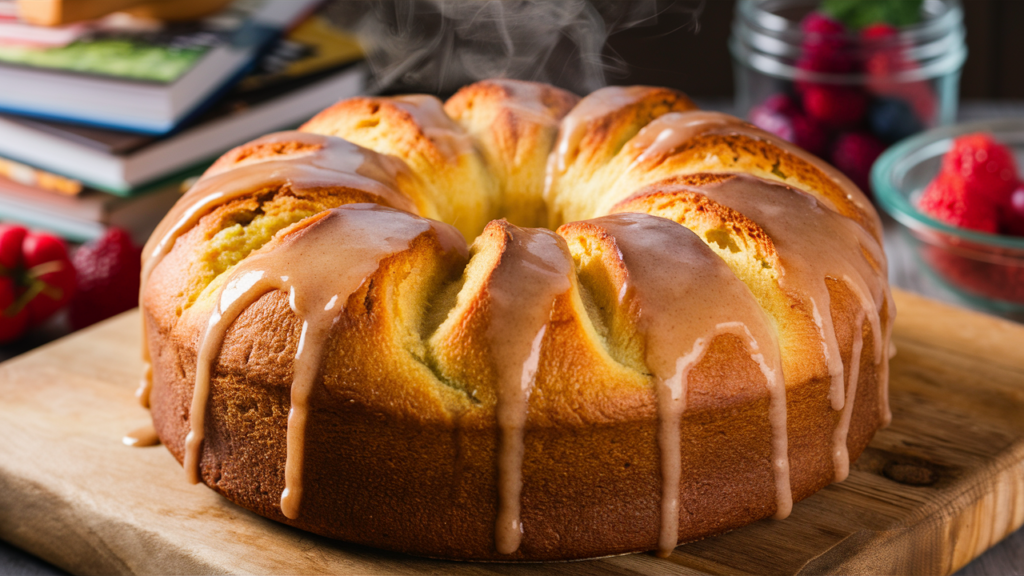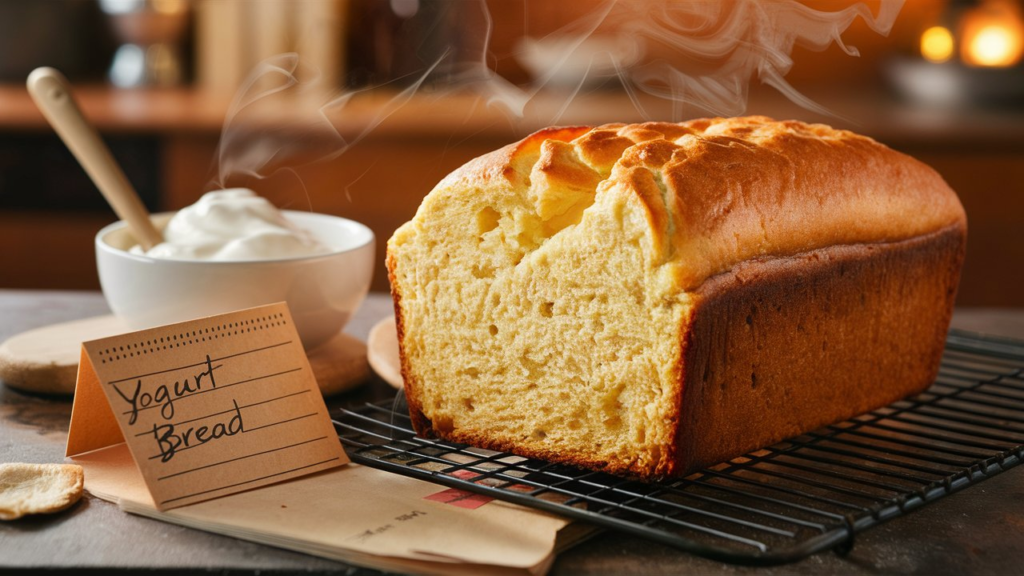Yogurt bread Recipe is a wonderfully moist and tender alternative to traditional bread recipes. Using yogurt as a key ingredient not only enhances flavor but also ensures a delightful texture, making it a perfect choice for those who enjoy homemade breads. This guide will walk you through the process of making yogurt bread, including tips for customization and variations to suit every taste.
The Basics of Yogurt Bread
What is Yogurt Bread?
Yogurt bread Recipe is a type of bread that incorporates yogurt into the dough, which contributes to its soft texture and slightly tangy flavor. The acidity of the yogurt also acts as a tenderizer, making the bread soft and pleasant to eat.
- Ingredients: Typically includes all-purpose flour, active dry yeast, yogurt, sugar, and salt.
- Texture and Flavor: The result is a tender crumb and a subtly tangy taste.
- Variations: Can be made with different types of yogurt, such as Greek yogurt or natural yogurt, to alter texture and flavor.
Benefits of Using Yogurt in Bread
Incorporating yogurt into bread recipes offers several benefits, both in terms of nutrition and bread quality.
- Moisture: Yogurt naturally adds moisture to the bread, keeping it softer for longer compared to traditional bread.
- Health Benefits: Yogurt is rich in calcium and probiotics, which are beneficial for digestive health.
- Versatility: Yogurt can be used in various types of bread, including sweet and savory varieties.
Necessary Equipment
Before starting your yogurt bread, it’s important to have the right tools on hand. This includes:
- Mixing Bowls: For combining ingredients.
- Measuring Cups and Spoons: For accurate measurement of ingredients.
- Bread Pan: To shape and bake the bread.
How to Make Yogurt Bread
Preparing the Dough
Making the dough for yogurt bread Recipe is a straightforward process that follows basic bread-making principles.
- Mixing Ingredients: Start by combining the dry ingredients, then add the yogurt and mix until a dough forms.
- Kneading: Knead the dough on a lightly floured surface until it becomes smooth and elastic.
- First Rise: Allow the dough to rise in a warm place until it doubles in size, which usually takes about 1-2 hours.
Baking Your Bread
Once your dough has risen, it’s time to bake it to perfection.
- Shaping: After the first rise, punch down the dough, shape it into a loaf, and place it in your bread pan.
- Second Rise: Let the shaped dough rise again until puffy and nearly doubled in size.
- Baking: Bake in a preheated oven at 375°F (190°C) for about 30-35 minutes or until the top is golden brown and the loaf sounds hollow when tapped.
Tips for Perfect Yogurt Bread
Achieving the perfect yogurt bread involves a few key considerations during preparation and baking.
- Yogurt Type: Using full-fat yogurt will give richer flavor and softer texture than non-fat varieties.
- Temperature: Ensure all ingredients are at room temperature to help the yeast work effectively.
- Proofing: Make sure the bread is properly proofed in a warm, draft-free environment to ensure optimal rise.
This section provides a comprehensive introduction to making yogurt bread, from the basic ingredients and equipment needed to detailed steps for preparing and baking the bread. The following sections will delve into different variations of yogurt bread, creative ways to serve and enjoy it, and troubleshooting tips to help you master the recipe.
Here’s the third part of the article on “yogurt bread recipe”:
Expert Tips for Perfecting Yogurt Bread

Achieving the Perfect Texture
The texture of yogurt bread can vary from dense and hearty to light and fluffy, depending on the ingredients and techniques used. Here are some tips to ensure the best texture:
- Proper Measuring: Use a kitchen scale to measure ingredients accurately. This precision ensures the right balance of ingredients, which is crucial for texture.
- Yogurt Type: The type of yogurt can greatly affect the moisture content. Greek yogurt, for instance, will make the bread denser than using a more fluid, traditional yogurt.
- Kneading Technique: Knead the dough just enough to develop the gluten, which gives the bread structure. Over-kneading can make the bread tough.
Ensuring Consistent Results
Bread making can sometimes be unpredictable, but these tips will help you achieve consistent results with your yogurt bread.
- Oven Calibration: Make sure your oven temperature is accurate with an oven thermometer. Even a slight deviation can impact baking time and bread texture.
- Proofing Environment: Create a stable environment for your dough to rise. The dough should ideally proof in a warm, draft-free area. Consistent temperature is key to consistent rising.
- Baking Stones: Using a baking stone can help evenly distribute heat and give your yogurt bread a better crust and rise.
Troubleshooting Common Issues
Even experienced bakers run into issues now and then. Here are solutions to some common problems when baking yogurt bread:
- Bread Not Rising: Check if your yeast is active. Also, ensure that the environment is warm enough for proofing.
- Too Dense: This could be due to not enough leavening (yeast or old yogurt), over-kneading, or too much flour.
- Crust Too Hard: Tent the bread with aluminum foil during the last third of baking to protect the crust from getting too hard.
Innovative Ways to Use Yogurt Bread
Breakfast Delights
Yogurt bread can transform your morning routine with these delightful breakfast ideas:
- French Toast: Use slices of day-old yogurt bread to soak up a rich custard for a luxurious French toast breakfast.
- Yogurt Bread Pancakes: Crumble the bread, mix it with a little milk and eggs, and fry on a skillet for unique pancakes.
- Breakfast Sandwiches: Use savory yogurt bread slices as the base for a hearty breakfast sandwich with eggs, cheese, and your choice of meats.
Gourmet Sandwiches and Snacks
Elevate your lunchtime with these gourmet sandwich and snack ideas using yogurt bread:
- Avocado Toast: Top a toasted slice of yogurt bread with smashed avocado, a squeeze of lime, and a sprinkle of chili flakes for a trendy and healthy snack.
- Vegetarian Delight: Layer hummus, sliced cucumbers, tomatoes, and sprouts on yogurt bread for a refreshing vegetarian sandwich.
- Mini Pizza Bases: Top small rounds of yogurt bread with tomato sauce, cheese, and your favorite toppings, then grill for a quick snack.

Dessert Transformations
Yogurt bread can also be a base for various desserts, showcasing its versatility beyond the usual applications.
- Bread Pudding: Cube the bread and soak it in a mixture of eggs, milk, sugar, and vanilla for a comforting bread pudding.
- Fruit Bruschetta: Top slices with mascarpone cheese, fresh berries, and a drizzle of honey for a simple yet elegant dessert.
- Chocolate Bread Ganache: Spread chocolate ganache over slices of sweet yogurt bread for a decadent treat.
These expert tips and innovative uses of yogurt bread not only enhance your baking skills but also expand the ways you can enjoy this versatile recipe. The final part of this blog will provide additional insights into making your yogurt bread experience truly exceptional, with a focus on pairing and seasonal variations.
You can get more recipes from here:

